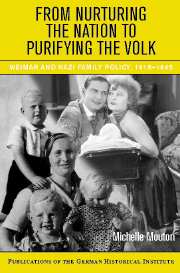Book contents
- Frontmatter
- Contents
- Acknowledgments
- List of Abbreviations
- Introduction
- 1 Marriage Policy in Turmoil
- 2 Divorce
- 3 From Mother's Day to Forced Sterilization
- 4 Alleviating the Burdens of Motherhood
- 5 Maternal Morality versus Infant Mortality
- 6 Forming Families beyond Blood Ties
- 7 Conclusion
- Bibliography
- Index
6 - Forming Families beyond Blood Ties
Foster Care and Adoption
Published online by Cambridge University Press: 05 January 2013
- Frontmatter
- Contents
- Acknowledgments
- List of Abbreviations
- Introduction
- 1 Marriage Policy in Turmoil
- 2 Divorce
- 3 From Mother's Day to Forced Sterilization
- 4 Alleviating the Burdens of Motherhood
- 5 Maternal Morality versus Infant Mortality
- 6 Forming Families beyond Blood Ties
- 7 Conclusion
- Bibliography
- Index
Summary
Furthermore, the foster parents commit themselves to keeping the child out of factories, mines, and other such business operations altogether and allow work around the house only insofar as it is in keeping with the child's strengths and does not put the child's physical, psychological or moral development at risk.
– Der Landeshauptmann der Provinz Westfalen, 20 July 1926The National Socialist worldview and its effect on population policy, development of the Volk [Volksaufartung], and spiritual renewal necessarily leads to the effort to incorporate the foster child as an important member of the entire German youth, into the nurturing Volksgemeinschaft as a comrade.
– Mutter und Volk, lead columnist Klara Lönnies, 8 May 1934During the Weimar and National Socialist eras, the belief that children were best off in families enjoyed almost unanimous support. Despite this, national demographics made it readily apparent that not all German children could be raised in traditional families. The vast number of orphans and fatherless and indigent children, together with the low birthrate and high infant mortality rate, propelled German officials to reconceptualize their role in helping families and children. It was in dealing with children whose families had broken down that the Weimar and National Socialist regimes faced their most urgent family-oriented responsibility: defining the institution of the family in such a way as to enable the creation of non–biologically based groups that functioned as families.
- Type
- Chapter
- Information
- From Nurturing the Nation to Purifying the VolkWeimar and Nazi Family Policy, 1918–1945, pp. 236 - 271Publisher: Cambridge University PressPrint publication year: 2007



